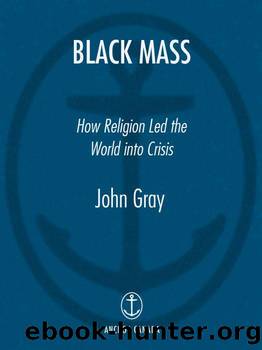Black Mass: How Religion Led the World into Crisis by John Gray

Author:John Gray [Gray, John]
Language: en-us
Format: mobi, epub
Publisher: Anchor Canada
Published: 2010-02-05T05:00:00+00:00
THE ORIGINS OF NEO-CONSERVATISM
When we forget, or wilfully choose to ignore, the intractability of human behaviour, the complexity of human institutions, and the probability of unanticipated consequences, we do so at great risk, and often immense human cost.
Jeane Kirkpatrick28
The United States is the last militant Enlightenment regime and the only advanced country that is still unshakably Christian. The two facts are not unrelated and help to explain the peculiar qualities of neo-conservatism and its rise to power in America. Despite its name, neo-conservatism is an ideology that originated on the Left. It has been able to gain power in America by allying itself with the Christian Right and with sections of liberal opinion. By allying itself at once with apocalyptic religion and a secular belief in human progress, the neo-conservative movement mobilized two powerful American traditions.
Like several other political labels, ‘neo-conservative’ was coined as a term of abuse. It seems to have been first used in the 1970s by the American socialist Michael Harrington to describe – and condemn –a small group of former leftists who were adopting stances in foreign policy that had in the past been confined to the Right. As the neo-conservative writer and Catholic theologian Michael Novak has written:
It is worth remembering that the first so-called neocons were a tiny band, indeed, usually quickly named as Irving Kristol and Gertrude Himmelfarb, the two Daniels, Bell and Moynihan, Norman Podhoretz and Midge Decter, and a very few of their intellectual friends. Virtually all of this company had a history as men and women of the left, indeed to the left of the Democratic party, maybe in the most leftward two or three per cent of Americans, in some case socialist in economics, in others social democratic in politics.29
The origins of neo-conservatism on the Left explain some of its persisting qualities. Many of the older generation of neo-conservatives began on the anti-Stalinist far Left – Irving Kristol, the political godfather of the movement, wrote an autobiographical essay called ‘Memoirs of a Trotskyist’30 – and the intellectual style of that sectarian milieu has marked the neo-conservative movement throughout its history. The chief figures who shaped the neo-conservative movement – such as Irving Kristol, the Harvard sociologist Daniel Bell, the editor of Encounter magazine Melvin Lasky, the writer and editor of Public Interest Nathan Glazer, the political scientist Seymour Martin Lipset and the Democratic politician Patrick Moynihan – did not take their intellectual nourishment from conservative thinkers. It is doubtful if they read much of Edmund Burke, the eighteenth-century parliamentarian who first articulated English conservatism, or of Benjamin Disraeli, the British prime minister whose novels contain an elegant statement of a conservative view of the world. If the present generation of neo-conservatives reads Russell Kirk or Michael Oakeshott –twentieth-century conservative thinkers, the first American and the second British, who aimed to deflate ideology in favour of practice –it is likely with distaste. All these conservative thinkers believed the ideological type of politics that emerged from the French Revolution was a destructive force that had wreaked havoc in the twentieth century.
Download
Black Mass: How Religion Led the World into Crisis by John Gray.epub
This site does not store any files on its server. We only index and link to content provided by other sites. Please contact the content providers to delete copyright contents if any and email us, we'll remove relevant links or contents immediately.
Letters From a Stoic by Seneca(2334)
The Valmiki Ramayana: Vol. 1 by Bibek Debroy(2175)
The Valmiki Ramayana: Vol. 2 by Bibek Debroy(2035)
The Valmiki Ramayana: Vol. 3 by Bibek Debroy(1859)
Mary Boleyn by Alison Weir(1461)
The Greeks by H. D. F. Kitto(1432)
The Notebooks of Leonardo Da Vinci by Da Vinci Leonardo(1250)
Art of Living by Sellars John;(1175)
Mythos (2019 Re-Issue) by Stephen Fry(1170)
The Voynich Manuscript by Gerry Kennedy(1163)
Annals by Tacitus(1159)
Medea and Other Plays by Euripides(1150)
The Classics by Mary Beard(1087)
Claudius the God by Robert Graves(1038)
Kadambari: Bana by Bana(1005)
Appeasement of Radhika by Muddupalani(1001)
Atlantis the Lost Continent Finally Found by Arysio Santos(999)
THE REPUBLIC by plato(992)
Beyond Control by Anthology(979)
